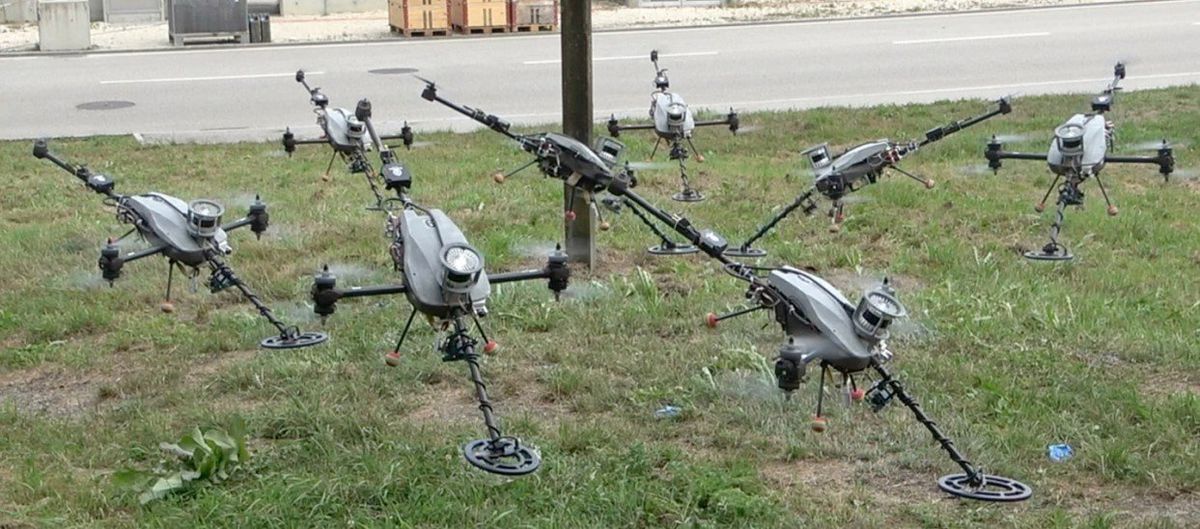EVAN ACKERMAN

Metal detecting can be a fun hobby, or it can be a task to be completed in deadly earnest—if the buried treasure you’re searching for includes land mines and explosive remnants of war. This is an enormous, dangerous problem: Something like 12,000 square kilometers worldwide are essentially useless and uninhabitable because of the threat of buried explosives, and thousands and thousands of people are injured or killed every year.
While there are many different ways of detecting mines and explosives, none of them are particularly quick or easy. For obvious reasons, sending a human out into a minefield with a metal detector is not the safest way of doing things. So, instead, people send anything else that they possibly can, from machines that can smash through minefields with brute force to well-trained rats that take a more passive approach by sniffing out explosive chemicals.
Because the majority of mines are triggered by pressure or direct proximity, it may seem that a drone would be the ideal way to detect them nonexplosively. However, unless you’re only detecting over a perfectly flat surface (and perhaps not even then) your detector won’t be positioned ideally most of the time, and you might miss something, which is not a viable option for mine detection.
But now a novel combination of a metal detector and a drone with 5 degrees of freedom is under development at the Autonomous Systems Lab at ETH Zurich. It may provide a viable solution to remote land-mine detection, by using careful sensing and localization along with some twisting motors to keep the detector reliably close to the ground.
The really tricky part of this whole thing is making sure that the metal detector stays at the correct orientation relative to the ground surface so there’s no dip in its effectiveness. With a conventional drone, this wouldn’t work at all, because every time the drone moves in any direction but up or down, it has to tilt, which is going to also tilt anything that’s attached to it. Unless you want to mount your metal detector on some kind of (likely complicated and heavy) gimbal system, you need a drone that can translate its position without tilting. Happily, such a drone not only exists but is commercially available.
The drone used in this research is made by a company called Voliro, and it’s a tricopter that uses rotating thruster nacelles that move independently of the body of the drone. It may not shock you to learn that Voliro (which has, in the past, made some really weird flying robots) is a startup with its roots in the Autonomous Systems Lab at ETH Zurich, the same place where the mine-detecting drone research is taking place.
So, now that you have a drone that’s theoretically capable of making your metal detector work, you need to design the control system that makes it work in practice. The system needs to be able to pilot the drone across a 3D surface that it has never seen before and might include obstacles. Meanwhile, it must prioritize the alignment of the detector. The researchers combine GPS with inertial measurements from a lidar mounted on the drone for absolute position and state estimation, and then autonomously plots and executes a “boustrophedon coverage path” across an area of interest. A boustrophedon—not a word I knew existed until just this minute—refers to something (usually writing) in which alternate lines are reversed (and mirrored). So, right to left, and then left to right.
Testing with metallic (nonexplosive) targets showed that this system does very well, even in areas with obstacles, overhead occlusion, and significant slope. Whether it’s ultimately field-useful or not will require some further investigation, but because the platform itself is commercial, off-the-shelf hardware, there’s a bit more room for optimism than there otherwise might be.
A research paper, “Resilient Terrain Navigation with a 5 DOF Metal Detector Drone” by Patrick Pfreundschuh, Rik Bähnemann, Tim Kazik, Thomas Mantel, Roland Siegwart, and Olov Andersson from the Autonomous Systems Lab at ETH Zurich, will be presented in May at ICRA 2023 in London.
No comments:
Post a Comment